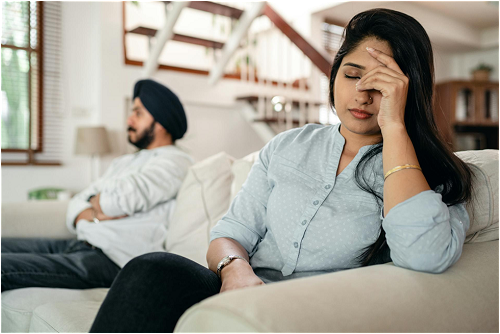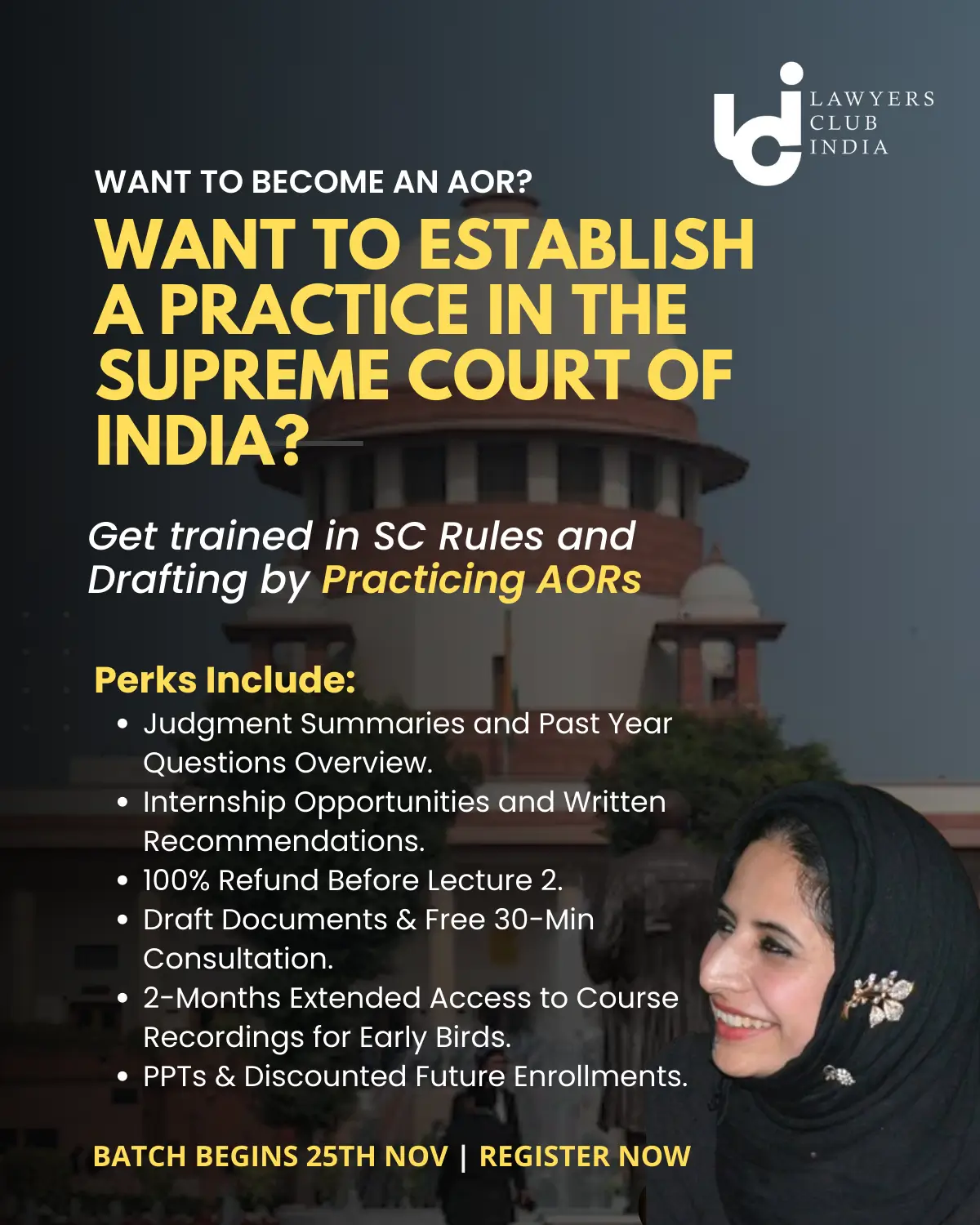KEY TAKEAWAYS
1) The word ‘divorce’ means “to make or keep separate”. It originated from the Latin word divortium which means separation. The Latin word divortere is also equivalent to the same.
2) The Indian Divorce Act, 1869, was the legislation that legalised divorce in India. Enacted in British India, this legislation gave Christians the privilege of seeking divorce from incompatible partners.
3) If both parties mutually consent to divorce, they can file a petition for the same in the Family Court, stating their wish to seek divorce as they are mutually incompatible to each other and cannot foresee a future where they can live happily together.
KEYWORDS
Divorce, Hindu Marriage Act, Indian Divorce Act, unregistered marriage
INTRODUCTION
Marriages are an indispensable part of Indian culture, especially in Hinduism. Marriages are seen as sacred institutions; as a way to achieve spiritual enlightenment. Such beliefs stem from religious texts like the Vedas, where patriarchy was the norm. Fathers chose the grooms for their daughters, who had no hand in their own future. Whoever was chosen as their partner would stay the same forever, since divorce was not an option in ancient India.
Marriages were seen as a special bond that united two families together for eternity. This bond offered many gains to both families, since resources could be shared between them in times of need, both in terms of money and people. The bride and groom, now the son and daughter in law, stood as the pillars that held these two families together. This meant that any disagreement between them would seriously affect both families; this was to be avoided at all costs, and hence divorce was never an option.
In the modern era, the patriarchal aspect of marriages has largely diminished, and women now hold the privilege to choose their partners. The significance of marriages is still as important as it was long ago, and the sanctity of marriages are still respected. Legislations now exist to regulate marriages that keep the sanctity of marriages intact while ensuring that basic principles of justice are still adhered to.
As mentioned earlier, divorce was never an option in the past, and one was forced to live with their partners even if they were not on good terms. This has changed with the aforementioned new legislations, like the Hindu Marriage Act, that allows a couple seeking divorce through mutual consent to legally divorce within six months of filing the application. This article intends to peruse through these legislations with the intent of laying down comprehensive information on divorces in India.
WHAT DOES DIVORCE MEAN?
The term divorce in itself means “to make or keep separate”. It comes from the Latin term divortium which means separation. Also equivalent to the term divortere, this word in legal language refers to the process of termination or legal dissolution of a marriage. Each religion has its process to get a divorce, which is coherent with the traditions and beliefs of that religion.

PHOTO CREDITS: KETUT SUBIYANTO
To avoid any confusion on the jurisdiction of each legislation with respect to religion, the following list is given:
- Christians: Indian Divorce Act, 1869
- Parsis: Parsi Marriage and Divorce Act, 1936
- Muslims: Dissolution of Muslim Marriages Act, 1939
- Hindus, Buddhists, Sikhs, and Jains: Hindu Marriage Act, 1955
- Inter-community marriages: Special Marriage Act, 1956
Divorce was first legalised in India with the Indian Divorce Act, 1869, which was enacted during British rule. This legislation provided Christians in India with the privilege to seek divorce if they were unhappy with their marriage. Hindus, Buddhists, Sikhs, and Jains received this privilege after the Hindu Marriage Act of 1955 was enacted post-independence.
GROUNDS FOR DIVORCE UNDER EACH LEGISLATION
INDIAN DIVORCE ACT, 1869
The Indian Divorce Act lists out the grounds under which a Christian can seek a divorce in its Section 10. The aggrieved party has to file the petition for divorce to the District Court under whose jurisdiction their marriage was solemnised or under whose jurisdiction they reside or have last resided together.
The grounds for divorce as per the same are:
- If either party commits adultery;
- If either party is no longer a Christian;
- If either party is of unsound mind for a period not less than two years;
- If either party is suffering from a sexually communicable disease for a term not less than two years immediately before the filing of the petition;
- If there is no information to confirm that either party is alive for a period of not less than seven years from those people who would have naturally known of the same;
- If either party refused to consummate their marriage;
- If either party has failed to comply with a decree of restitution of conjugal rights for a period of two years or more from the date the decree was passed against the respondent;
- If they deserted the petitioner for a period not less than two years immediately preceding the date of filing of the petition;
- If the respondent treated the petitioner with such cruelty that it would be reasonable for them to assume that living with the respondent would be harmful or injurious;
- A wife may file an application for divorce if after the solemnisation of their marriage, the husband has been found guilty of rape, sodomy, or bestiality.
PARSI MARRIAGE AND DIVORCE ACT, 1936
Section 32 of the Parsi Marriage and Divorce Act, 1936 explains the grounds that can be used against a person to obtain divorce. They are as follows:
1) The marriage has not been consummated within one year because the defendant refused to do so;
2) The defendant was of unsound mind at the time of the marriage, and has been habitually so till date, along with any of the following conditions holding true:
- a) The plaintiff was ignorant of this fact at the time of marriage;
- b) They filed a suit within three years from the date of marriage;
3) If at the time of the marriage, the defendant was pregnant due to some other person other than the plaintiff, along with the following conditions being true:
a) The plaintiff was ignorant of this fact at the time of marriage;
b) The petition has been filed within two years from the date of the marriage;
c) Marital intercourse has not taken place after the plaintiff learned this fact.
4) If the defendant committed adultery, formication, bigamy, or any unnatural offence after the marriage, the suit for which should be filed within two years from the date on which they learned this fact;
5) If the defendant subjected the plaintiff to such cruelty that it would be considered against reason for any Court to compel the plaintiff to live with them;
6) If the defendant caused grievous hurt to the plaintiff, or if they infected them with a venereal disease, or if they forced the plaintiff to submit herself to prostitution, the suit for which should be filed within two years from the date of the incident;
7) If the defendant is undergoing imprisonment for a term of seven years or more, provided the defendant has already undergone at least one year of imprisonment from this period;
8) If the defendant deserted the plaintiff for at least two years;
9) If a Magistrate has passed an order directing the defendant to pay maintenance to the plaintiff, and since one year they have not had marital intercourse from the date of passing the order or decree;
10) If the defendant is no longer a Parsi.
DISSOLUTION OF MUSLIM MARRIAGES ACT, 1939
Section 2 of this legislation lists out the grounds on which a marriage can be dissolved. They are:
- If there is no information on the whereabouts of the husband for at least four years;
- If the husband does not provide maintenance to his wife for a period not less than two years;
- If the husband has been sentenced to imprisonment for a period of seven years or more;
- If without reasonable cause, the husband does not commit to his marital obligations;
- If the husband was impotent at the time of marriage and continues to be so till date;
- If the husband has been insane for at least two years, or is suffering from a sexually communicable disease;
- If the wife, who was promised for marriage before they attained fifteen years of age by their father or guardian, refuses to honour such promise for marriage before attaining eighteen years of age;
- If the wife is being treated with cruelty by the husband, like causing grievous hurt, forcing her to lead an immoral life, obstructing her right to practise her religion, etc;
- Or any other ground recognised as a valid ground for divorce under Muslim Law.
HINDU MARRIAGE ACT, 1955
The Hindu Marriage Act, 1955, specifies the grounds that can lead to a divorce in its Section 13, as follows:
- If either party had voluntary sexual intercourse with any individual other than his or her spouse;
- If the defendant treated the plaintiff with cruelty after the solemnisation of their marriage;
- If the defendant deserted the petitioner for period not less than two years immediately preceding the date of filing the petition;
- If the defendant is no longer a Hindu;
- If the defendant suffers from an incurable mental unsoundness or any other mental disorder of such degree that the petitioner cannot be reasonably expected to live with them;
- If the defendant suffers from any sexually communicable disease;
- If the defendant has renounced the world by entering any religious order;
- For a period of seven years or more, no information that could confirm that the defendant is still alive has been received by the close relatives of the defendant.
- If after the passing of an order of judicial separation to which both were parties, there has been no cohabitation for a period of at least one year;
- If there has been no restitution of conjugal rights for a period of at least one year after an order directing the same has been passed, to which both were parties;
- If after the solemnisation of the marriage, the husband has been found guilty of rape, sodomy, bestiality, etc.;
- If after awarding maintenance to the wife, there has been no cohabitation between both parties for a period of at least one year;
- If her marriage was solemnised at the age of fifteen, and she has since then repudiated such marriage before attaining the age of eighteen years;
SPECIAL MARRIAGE ACT, 1954
Section 27 of the Special Marriage Act, 1954, lists out the grounds upon which a divorce can be obtained, as follows:
- If the defendant had voluntary sexual intercourse with any other person other than their spouse after the solemnisation of their marriage;
- If the defendant deserted the petitioner for a period not less than two years immediately preceding the date on which the petition was filed;
- If the petitioner is undergoing a sentence of imprisonment for a term not less than seven years;
- If the defendant had since the solemnisation of the marriage treated the petitioner with cruelty;
- If the defendant is of unsound mind or suffers from a mental disorder of such degree that the petitioner cannot be reasonably expected to live with the defendant;
- If the defendant suffers from a sexually communicable disease;
- If the defendant suffers from leprosy, provided they did not contract it from the petitioner themself;
- If the defendant has not been heard of as being alive for a period not less than seven years by those people who would have naturally heard of the same;
- If the husband has been found guilty of rape, sodomy, or any other sexual offence after the solemnisation of their marriage;
- If there has been no cohabitation between the parties after an order directing the husband to pay maintenance was passed, for a period not less than an year;
- If there has been no restitution of conjugal rights after the passing of an order or decree for the restitution of conjugal rights have been passed, for a period not less than one year;
- If there has been no cohabitation between the parties after an order directing the judicial separation between the parties was passed, for a period not less than one year.
PROCEDURE TO BE FOLLOWED FOR A DIVORCE
FILE A DIVORCE PETITION
In case of a mutual divorce, a joint petition for the same can be filed in the Family Court by both the husband and wife, stating that they have been residing separately for a period of over one year, and that they have not been able to compatibly live together and therefore wish to terminate their marital bond. This petition should be signed by both parties.

PHOTO CREDITS: COTTONBRO STUDIOS
COURT PROCEEDINGS
After receiving the petition for divorce, the Court will examine the petition along with all the relevant documents submitted with it. Both spouses are required to appear before the Court with their counsels for this process. The Court may initiate a reconciliation process, and if the parties are found to be irreconcilable, the divorce proceedings begin.
The Court may order both parties to record their statements on oath, after which an order on the first motion is issued by the Court. A period of six months is given to both parties, after which the parties may file for a second motion. The maximum period allowed to file for the second motion is eighteen months.
If both parties still wish to proceed with the divorce procedures, the second motion shall be filed, and both parties may proceed towards the final hearings. If the second motion is not passed within eighteen months, no decree for divorce shall be passed. The Supreme Court has also held that the six months period can be waived off if the Court is of the opinion that these six months will only add to the suffering of the parties.
Anytime before the final order has been passed, the parties may withdraw their consent to divorce. For the complete dissolution of a marriage, mutual consent between both the parties is of great importance. If any serious allegation against the defendant is found true, there will be no chance of reconciliation and the Court may pass an order for divorce.
DIVORCES FOR UNREGISTERED MARRIAGES
Since the registration of the marriage is not mandatory in some places and beliefs, even unregistered marriages can be divorced with the same procedure followed in case of a registered marriage. In these cases, the proof of marriage is of great significance, as there is no legal document to prove the same. The rituals and customs followed in the marriage, along with all the guests who witnessed the marriage, serve as the proof for the same.
PROMINENT REASON FOR DIVORCE IN INDIA
The most common reason in modern India that leads people to divorce is education. This might come as a surprise to some but education both increases the chance of a lasting marriage as well increases the chance of a divorce. The primary reason for this is that earlier, women did not have access to education, or were restricted from accessing it. Either way, their remoteness from education had significant implications in their life with respect to their marriage.
Women were not given the choice to select their future partners, instead, it was their father or their guardian who chose the same. They employed a multitude of techniques to choose this person, all of which were drenched with superstition. The actual reason in most cases was the financial situation of the future son-in-law and not the degree of compatibility they shared with the daughters.

PHOTO CREDITS: MAREK STUDZINSKI
Studies show that with an increase in development, a large number of women in our country now have access to education, as well as the right to choose their partners. This means that women can now find those partners who are more compatible with them, and also that since they are more aware of their rights and the laws related to marriage, divorce is now an option in case of incompatibility with their partners. This led to an increase in both the rate of successful marriages as well as the rate of divorces in the country.
This is in line with the fact that in urban cities like Delhi, Mumbai, and Bengaluru, the rates of divorce are as high as thirty percent. This shows the significance of education in the enforcement of the rights of women. In fact, the state of Maharashtra has the highest rates of divorce in the Country in the year 2023, followed by Delhi, and Kerala.
POWER OF THE SUPREME COURT TO GRANT DIVORCES
The Supreme Court clarified in the case of Shilpa Sailesh v. Varun Sreenivasan that the Supreme Court is not bound by the procedures to grant a divorce mentioned in the Hindu Succession Act, 1955, or any such legislation for that matter. On the grounds of “irretrievable breakdown of marriage”, the Supreme Court can exercise its authority vested on it by the Constitution in Article 142 to pass such an order or decree for the purpose of doing complete justice.
Even when the main case is pending before the Family Court, the Supreme Court, irrespective of this fact, can directly grant a divorce without following the procedures and waiting times that the subordinate courts are bound to follow. Even if one party is opposed to the divorce, the Apex Court can grant a divorce without any of the priorly mentioned procedures in the interest of justice, if it deems that there has been an “irretrievable breakdown” of the marriage.
THE STIGMA ASSOCIATED WITH DIVORCE
As mentioned previously, there was no option to dissolve a marriage in Ancient India. Ancient texts like the Manusmriti associated marriages with a certain level of sanctity that prevented the dissolution of a marriage even if there was no chance of reconciliation. Divorce was stigmatised in ancient culture, and women who were bold enough to proceed with one were often called disloyal to their community and beliefs.
The stigma associated with divorce still continues, and although education has improved the situation to a great extent, it is no lie that the problem still persists, albeit in a more camouflaged form. There are still families that do not allow their daughters to seek divorce even when the relationship between their daughter and their son-in-law is irreconcilable. Divorce is still considered a social wrong by many, which discourages women from proceeding with it.
WOMEN, CHILDREN, AND DIVORCES
Till now we have gone over the process of getting a divorce from an incompatible partner. But what about life after that? As discussed earlier, divorce is still a taboo in many parts of India. This entails a large amount of problems for the mother and child. Divorce being an undesirable topic means that divorcees are isolated from society. This is mostly done to women and children than to men, who are more likely to be encouraged to remarry.
Studies show that divorced women and children are subject to greater social isolation, making them feel more and more lonely, unhappy, and lowers their self esteem. The biggest issue with this is that children, being in a growing stage, are more affected by this than their mothers, leaving them scarred for a lifetime. Such scars leave children wanting for more love and respect from society, forcing them into delinquent behaviour in hopes of the same.
Surviving in a society that alienates you just because you chose to live a happy life is no less than a feat. The image of a divorcee in society is considered lower than the average person. They suffer from mental health issues that were caused by alienation from society, after which they are isolated again because of this reason. Survival is a never ending fight for people like these who are considered to be the lower part of society.
CONCLUSION
Divorce is still a difficult topic to digest for most Indians because of the stigma associated with it since the Vedas. From a time when divorce was never an option, we have evolved to a society where the average woman can get a divorce from their partner without too much trouble. Legislations like the Special Marriage Act and the Hindu Marriage Act is what allowed for this achievement.
Education has been found to be the catalyst for an increase in the rates of both durable relationships and divorces. An educated woman is more aware of her rights and also knows the kind of person she is most compatible with. They can also get a divorce if it is found later on that her assumptions were wrong. Although divorce is still a stigma for Indians, developed cities like Mumbai and Delhi see a large amount of divorces.
FREQUENTLY ASKED QUESTIONS
- What is the meaning of the term “divorce”?
ANS: Originating from the Latin word divortium, the word divorce means “to make or keep separate”. It is also equivalent to the term divortere. Every faith has its own beliefs and practices pertaining to the dissolution of a marriage. Some might not entertain such separation at all, while some might in the interest of justice. Generally, those couples seek divorce who find themselves to be mutually incompatible with each other. Legislations like the Hindu Marriage Act have been drafted with the intention of providing a remedy to couples in distress. - Were marriages seen as a sacred institution in the past?
ANS: In ancient texts like the Vedas and the Manusmriti, marriages were seen as a sacred institution. They were seen as a path to spiritual enlightenment through all forms of pleasure. This sanctity associated with marriage makes seeking divorce an arduous task. Divorce was not allowed in Hinduism earlier, although it was permitted later due to stricter legislations. The sanctity of marriages still persists in the mind of the average Indian, although it has reduced in its degree. - What is the procedure to file a divorce petition?
ANS: If both the husband and wife agree on mutual consensus to get divorced, they may file a petition for the same in the Family Court, stating that both parties have not been able to live compatible with each other and do not see a future of such, and therefore wish to terminate their marital bond. Both parties are required to sign this petition. The Court will examine the petition filed by the couple and examine the evidence submitted. - Can the Supreme Court grant divorces without following the procedures prescribed in any legislation?
ANS: The case of Shilpa Sailesh v. Varun Sreenivasan provided the Apex Court with an opportunity to clarify on its jurisdiction and authority over matters of divorce. The Court stated that it can grant divorce without going through any procedure or providing any waiting period of six to eighteen months that is usually provided by the Family Court, if the Court is of the opinion that the relationship is “irreconcilably broken”. - How does divorce affect a woman and a child?
ANS: The stigma associated with divorce deeply affects a woman and her child. Our society has a tendency to alienate divorcees, but when the divorcee is a woman, the degree of alienation increases drastically. Society often advises divorced men to move on and remarry, but women are often criticised for their decision. Their act of standing up for themselves is criticised to an extent that both women and children start feeling lonely and alienated. This later leads to mental problems like depression and mental insta
Join LAWyersClubIndia's network for daily News Updates, Judgment Summaries, Articles, Forum Threads, Online Law Courses, and MUCH MORE!!"
Tags :family law













